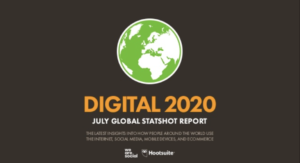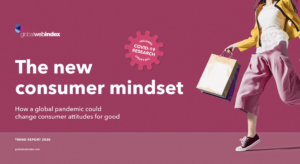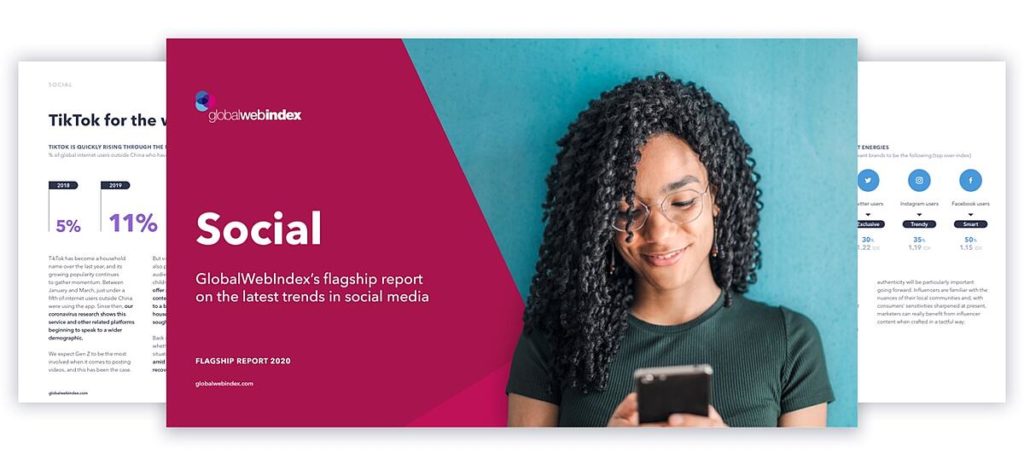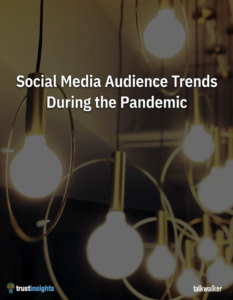
It’s not post-pandemic, its intra-pandemic.
We’re still in it, and the implications to marketing are long-reaching.
One of the ongoing regimens we maintain at Convince and Convert is the continual review and analysis of research reports from dozens of sources. It’s part of what allows us to base our ideation and recommendations on data as opposed to just good ideas. It comes as no surprise this year, the annual glut of, “What new in [insert topic here] for 2020” articles and trend analysis were quickly rendered obsolete by early March. The majority of the data collection for all the year-end research reports happened in the third and fourth quarter of 2019 to capitalize on the typical New Year’s planning frenzy and publishing cycle. COVID-19 changed everything.
Marketers were starting from scratch and all our previous “norms” were tossed out the window, whether we believed it or not.
All those thoughtfully administered surveys, painstakingly analyzed, identifying the key take-aways, all those beautifully designed charts and graphs, and the upcoming predictions became largely null and void. Marketers were starting from scratch and all our previous “norms” were tossed out the window, whether we believed it or not.
We are beginning to see the arrival of newly updated research reports and survey results being published intra-pandemic. We review and curate the best into the database we maintain for our ongoing consulting work. I’ve selected five of the best, newly released, intra-pandemic research reports that have recently come across our home-office desks.
- The State of Digital 2020 — Global Q3 Update: A Comprehensive Look at the State of the Internet, Mobile Devices, Social Media, and Ecommerce
- The Annual CMO Spend Survey Research 2020-21 [Part 1]
- The New Consumer Mindset: How a Global Pandemic Could Change Consumer Attitudes for Good
- Social: GlobalWebIndex’s Flagship Report on the Latest Trends in Social Media
- Social Media Audience Trends During the Pandemic
1. The State of Digital 2020 — Global Q3 Update: A comprehensive look at the state of the internet, mobile devices, social media, and ecommerce.
Published by Hootsuite and We Are Social, July 2020, 186 pages, link to Global Q3 update and regional reports
Research Overview:
 These Digital 2020 reports show digital, mobile, and social media have become an indispensable part of everyday life for people all over the world. More than 4.5 billion people are using the internet at the start of 2020, while social media users have passed the 3.8 billion mark. Nearly 60 percent of the world’s population is already online, and the latest trends suggest that more than half of the world’s total population will use social media by the middle of this year.
These Digital 2020 reports show digital, mobile, and social media have become an indispensable part of everyday life for people all over the world. More than 4.5 billion people are using the internet at the start of 2020, while social media users have passed the 3.8 billion mark. Nearly 60 percent of the world’s population is already online, and the latest trends suggest that more than half of the world’s total population will use social media by the middle of this year.
This is an amazing collection of information. This links to an index page containing Hootsuite’s collection of Global State of Digital reports. Additional country-specific reports are also available (e.g., USA-specific as of January 2020.) Some of them were not downloadable at the time of this review. (Tip: go to the SlideShare and from there you are able to print PDFs of the decks) This is a gold mine — just be willing to dig a little.
Key Takeaways:
- From a variety of perspectives, the impact of COVID-19 across all digital channels has impacted behaviors and consumption. Details are in dozens of the slides/charts.
- The global lens on all of this is valuable and may be best when contrasted against the corresponding USA or other country-specific reports (also available from the linked index page).
2. The Annual CMO Spend Survey Research [2020-21 Part 1]
Published by Gartner, June 2020, 27 pages, link to the full report
Research Overview:
 As CMOs respond to the COVID-19 crisis and social tensions, this year’s survey captures strategies, budgets and priorities at a time of upheaval. This report, one of a two-part series, also examines ways CMOs plan to maintain and grow revenue into 2021.
As CMOs respond to the COVID-19 crisis and social tensions, this year’s survey captures strategies, budgets and priorities at a time of upheaval. This report, one of a two-part series, also examines ways CMOs plan to maintain and grow revenue into 2021.
Additional recommendations for CMOs are sprinkled within. This is good guidance for larger organizations, or to bolster forward-looking marketing recommendations. Also a helpful perspective if you are planning market expansion, product launch or M&A. Part two of the series is here.
Key Takeaways:
- CMOs dismiss economic pessimism as 73% expect COVID-19’s near-term negative impacts to be short-lived, at odds with the expectations of C-suite colleagues.
- Despite their positive outlooks, almost half of CMOs (44%) are facing midyear budget cuts in 2020 as a direct result of the COVID-19 pandemic. Eleven percent expect their budgets to face significant cuts of more than 15%.
- To reconcile their economic optimism with their budget limitations, CMOs continue to pursue relatively conservative growth strategies, with 79% primarily relying on existing markets to fuel growth.
3. The New Consumer Mindset: How a Global Pandemic Could Change Consumer Attitudes for Good
Published by GlobalWebIndex, July 2020, 14 pages, link to the full report
Research Overview:
 This consumer report is on the changes to know during coronavirus distills global data into the facts to know. You’ll uncover the freshest market research, collected up to April 2020, to reinvigorate your marketing strategies.
This consumer report is on the changes to know during coronavirus distills global data into the facts to know. You’ll uncover the freshest market research, collected up to April 2020, to reinvigorate your marketing strategies.
It is an enlightening, quick look at five areas of changed consumer mindset each with a graphic and more details. The charts and underlying data are dynamic and you can access them via the PDF and drill down for further analysis. That is pretty slick for you data-junkies! (Free account required.)
- The status quo of privacy, and how consumers feel.
- Ways in which personal outlook is impacting brand needs and purchase drivers.
- The impact of a slower lifestyle on consumers’ interests and media.
- The psychographic insights you should be following.
Key Takeaways:
- Data for Good—Personal Data Concerns Are Down
Internet users appear willing to suspend their usual concerns with personal data to assist contact tracing software. It may also bring us closer to fair monetization of personal data in the long-run. (slide 5) - Exclusivity Excluded—Exclusivity, Status, and Reputation are Much Less Relevant
Consumers will be less likely to want to stand out from the crowd, and will want more solidarity within the collective. Focusing on values, purpose, and a brand’s contribution to the common good may be received better than strategies that try to put consumers apart from the pack. Emphasize practicality over exclusivity where possible over the coming months. (slide 6) - Life in the Slow Lane—Free Time, and Screen Fatigue Creates Space for Offline Activities
Be aware of media fatigue caused by the creation of new free time. Consider how to engage and support consumers wanting to look away from their screens, as McDonald’s and Kraft Heinz have through branded jigsaw puzzles. (slide 7) - Tightened Purse Strings—The Post-Affluent Mindset
Consumers may become more cautious and discreet when spending. Sellers of non-essential goods may have to find ways to make their products seem like essentials, rather than extras. (slide 8)
Comparing year-over-year stats is meaningless. Don’t bother.
4. Social: GlobalWebIndex’s Flagship Report on the Latest Trends in Social Media
Published by GlobalWebIndex, June 2020, 32 pages, link to the full report
Research Overview:
 This is another very good research report from a global perspective. As above, the charts and underlying data are dynamic and you can access them via the links PDF and drill down for further analysis. That is pretty slick for you data-junkies! (Free account required.)
This is another very good research report from a global perspective. As above, the charts and underlying data are dynamic and you can access them via the links PDF and drill down for further analysis. That is pretty slick for you data-junkies! (Free account required.)
This report focuses on:
- Post-COVID perspectives on social media—how has the pandemic built upon or reversed key attitudes toward social media?
- The social media landscape—which social platforms are most popular, and have made the most headway in recent months?
- Social media behaviors—how have social media behaviors changed over the last year and since the outbreak?
- The social purchase journey—how is the momentum for social commerce looking, both before we started seeing the pandemic’s impact on media habits, and since?
Key Takeaways:
- Social media has become the bedrock of our digital news habits
Staying up-to-date with news and current events is the most commonly cited reason for using social platforms, and the COVID-19 pandemic has accelerated the global trend of relying on these sites for information updates. - Digital consumers are using social media for entertainment purposes on a greater scale than before the outbreak
But recent events have given the more “social” elements of social media a new lease of life. - Younger consumers are understandably using social media, messaging services and apps more due to the outbreak
But there are signs of Gen Z reverting back to old usage habits, as baby boomers continue to diversify their behaviors over the course of the pandemic. - Many younger consumers have taken to livestreaming in the last few months
The question is whether livestreaming is a likely post-pandemic game changer for certain industries. With 23% of consumers planning to continue watching more videos post-outbreak, the future of livestreaming looks promising. - Social media ads have brought consumers closer to brands during the pandemic, but closing sales remains a challenge
With only 13% saying a “buy” button would most increase their likelihood of purchasing, it’s clear that an uncommitted approach to social commerce won’t be enough to put the spending wheels in motion.
5. Social Media Audience Trends During the Pandemic
Published by Talkwalker & Trust Insights, April 2020, 42 pages, webinar and link to full report
Research Overview:
 Talkwalker and Trust Insights teamed up to analyze day-by-day data for over 60 different social networks, from the biggest tech companies to niches you’ve probably never heard of.
Talkwalker and Trust Insights teamed up to analyze day-by-day data for over 60 different social networks, from the biggest tech companies to niches you’ve probably never heard of.
In this report, you’ll learn which networks grew the most in the early weeks of the pandemic, which networks are holding onto their audiences, and the three big trends to take advantage of as we navigate the ever-changing situation: gaming, YouTube video, and home-based niches. You’ll see practical examples of brands and techniques, Action Steps and takeaways at each major trend, and ways to pivot your marketing.
This is an excellent compilation of changes in social network usage pre- and intra-pandemic (data gathered during the initial six week period). It contains good insights and rationale for tactical changes to capitalize on those user behavior changes.
Key Takeaways:
We can broadly classify the platforms that have shown growth and strength in three general categories: gaming, video, and home-based niches.
Gaming
- Identify the gaming franchises your audience participates in, then match rewards/giveaways to that franchise if possible to engage your audience.
- Identify influencers for your gaming franchise of choice based on audience feedback, and cross match them to your existing influencers and brand guidelines.
Video
- Benchmark your current YouTube performance, if available, based on the engagements/views ratio above. If your videos are underperforming, consider changing YouTube content strategies.
- Identify, using a media monitoring tool like Talkwalker, who the top creators in your industry or niche are, and start building relationships with them.
Home-based Niches
- With the home-based niche network you’ve identified as resonant with your audience, scan content trends and start creating appropriate content to share with your audience and the network at large.
- Stimulate community discussions with known relevant topics based on niche social network conversations.
Comparing year-over-year stats is meaningless. Don’t bother. The old paradigms got tossed and it’s time to deal with the new paradigms. It’s a lot of work to revamp the marketing plan going forward, but at least now there is new, highly relevant data and research becoming available. Take advantage of the resources at your disposal and make data-informed plans and decisions.
The post COVID-19: What It Means for Your Marketing (Research and Reports) appeared first on Content Marketing Consulting and Social Media Strategy.
from Content Marketing Consulting and Social Media Strategy https://ift.tt/2GeWz7t



No comments:
Post a Comment